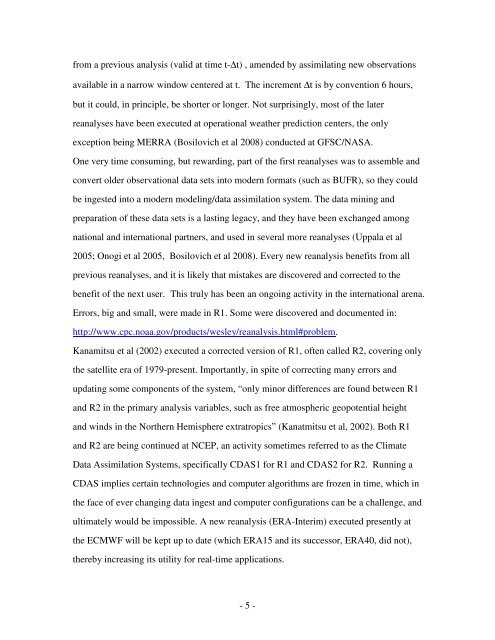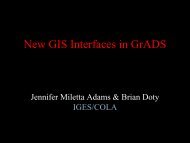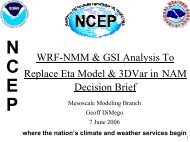The NCEP Climate Forecast System Reanalysis - NOAA National ...
The NCEP Climate Forecast System Reanalysis - NOAA National ...
The NCEP Climate Forecast System Reanalysis - NOAA National ...
You also want an ePaper? Increase the reach of your titles
YUMPU automatically turns print PDFs into web optimized ePapers that Google loves.
from a previous analysis (valid at time t-∆t) , amended by assimilating new observationsavailable in a narrow window centered at t. <strong>The</strong> increment ∆t is by convention 6 hours,but it could, in principle, be shorter or longer. Not surprisingly, most of the laterreanalyses have been executed at operational weather prediction centers, the onlyexception being MERRA (Bosilovich et al 2008) conducted at GFSC/NASA.One very time consuming, but rewarding, part of the first reanalyses was to assemble andconvert older observational data sets into modern formats (such as BUFR), so they couldbe ingested into a modern modeling/data assimilation system. <strong>The</strong> data mining andpreparation of these data sets is a lasting legacy, and they have been exchanged amongnational and international partners, and used in several more reanalyses (Uppala et al2005; Onogi et al 2005, Bosilovich et al 2008). Every new reanalysis benefits from allprevious reanalyses, and it is likely that mistakes are discovered and corrected to thebenefit of the next user. This truly has been an ongoing activity in the international arena.Errors, big and small, were made in R1. Some were discovered and documented in:http://www.cpc.noaa.gov/products/wesley/reanalysis.html#problem.Kanamitsu et al (2002) executed a corrected version of R1, often called R2, covering onlythe satellite era of 1979-present. Importantly, in spite of correcting many errors andupdating some components of the system, “only minor differences are found between R1and R2 in the primary analysis variables, such as free atmospheric geopotential heightand winds in the Northern Hemisphere extratropics” (Kanatmitsu et al, 2002). Both R1and R2 are being continued at <strong>NCEP</strong>, an activity sometimes referred to as the <strong>Climate</strong>Data Assimilation <strong>System</strong>s, specifically CDAS1 for R1 and CDAS2 for R2. Running aCDAS implies certain technologies and computer algorithms are frozen in time, which inthe face of ever changing data ingest and computer configurations can be a challenge, andultimately would be impossible. A new reanalysis (ERA-Interim) executed presently atthe ECMWF will be kept up to date (which ERA15 and its successor, ERA40, did not),thereby increasing its utility for real-time applications.- 5 -





